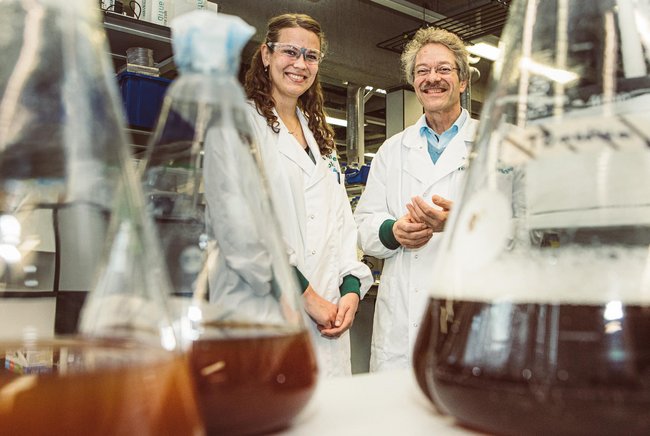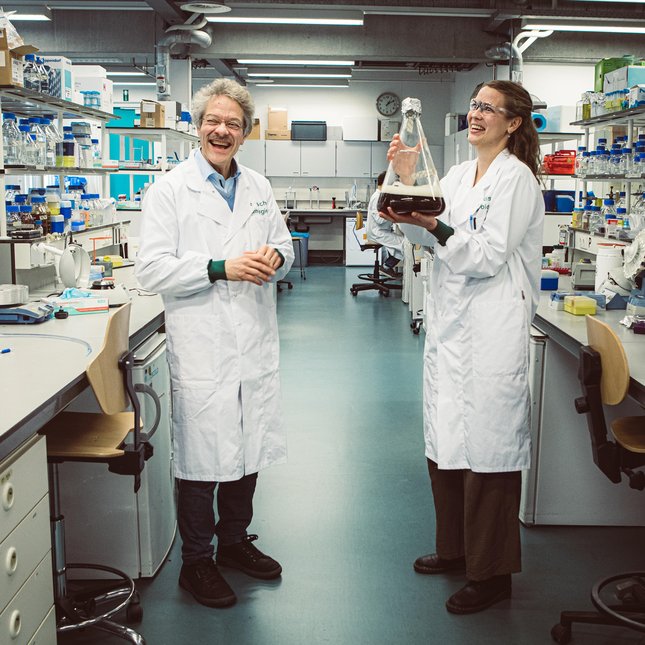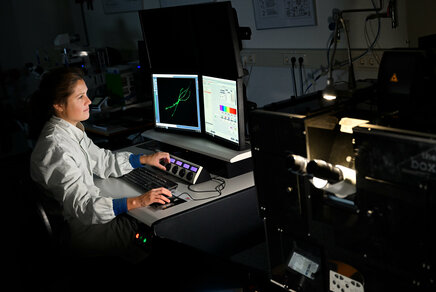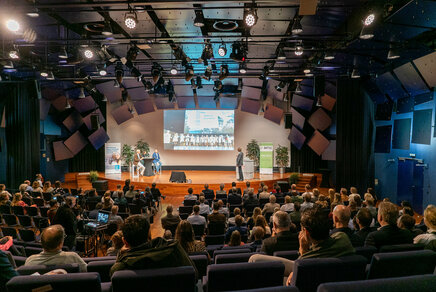Get ready for the biosensor future
Biosensors are set to revolutionize healthcare and our researchers are leading this revolution.

One of the tools for managing the spread of a viral infection such as COVID-19 is an antigen test, which is a so-called point-of-care test that someone can use from the comfort of their own home. Technically speaking, these tests are biosensors, and Leo van IJzendoorn (63) and Eva van Aalen (26) know a thing or two about biosensors. Although they’re working on different types of biosensors and come from different generations, they have common visions on the future of biosensors. We sat down with the pair to discuss the past, present, and future of biosensors.
POWER TO THE PIONEERS
TU/e is celebrating its 65th anniversary, which is why in this lustrum year we are making a link between the past, the present and the future. In a series of double interviews we bring together pioneers from the past and present; pioneers who may have grown up in a different era, but who do share a common passion for a particular discipline. How do they view the (scientific) developments of then and now? What are the similarities and what are the differences? The earlier parts focused on photonics, sustainable mobility, and robotics.
In the late 1950s and early 1960s, the world met biosensors, thanks in part to the work of Leland C. Clark Jr and his biosensor for measuring the degree of oxygenation in blood. One of his initial designs even included cellophane wrapper from a cigarette packet, which helped to improve the quality of the signal from the biosensor! This ingenious solution demonstrates the humble beginnings for the biosensor.
Fast forward 60 years or so and things have changed drastically for biosensors. The need to detect and quantify molecules in biological samples is important not only for healthcare (think of the COVID-19 pandemic), but also for industry and the environment. There is considerable demand for more accurate and easy-to-use biosensors. Biosensors are here to stay.

Lots of possibilities
“It’s a great field with lots of possibilities.” That’s how Leo van IJzendoorn views the ever-growing field that is biosensors. However, Van IJzendoorn didn’t start out in the field of biosensors, or even medical sensors, as his career took several twists and turns before he ended up working on biosensors.
“I studied both chemistry and physics at Leiden University, before completing a PhD in astrophysics,” recalls Van IJzendoorn. For his PhD work, Van IJzendoorn explored the microparticles that are found in molecular clouds in space, which sounds astronomically far from biosensors.
“After my PhD, I joined Philips to work on ion beam physics, and then moved to TU/e to work at the cyclotron laboratory. First, I was analyzing materials with ion beams, but then we started making radioisotopes, which involved working with people from chemistry,” says van IJzendoorn.
From ion beams to viruses
And that’s where his chemistry background came to the fore. In 2004, the department of Applied Physics wanted to set up a biophysics group, which would include biosensing.
Around the same time, Van IJzendoorn had a sabbatical at Philips where he shared an office with current TU/e professor and biosensor researcher Menno Prins.
“Menno and I would talk about biosensing principles all the time, and I participated in a biosensor project at Philips,” recalls Van IJzendoorn. “The university wanted the bio-sensing group but also wanted someone with a little more experience in the field of biosensors. So, Menno got involved while still at Philips, and I became the operational leader of the biosensing group at Applied Physics.”
Doctoral inspiration
Like van IJzendoorn, Eva van Aalen knows the TU/e campus quite well. She had already completed a Bachelor’s degree and a Master’s degree in biomedical engineering at TU/e before venturing into the world of PhD research at TU/e, where she’s based in the Protein Engineering group led by Maarten Merkx.
“My parents are both family doctors, so at the dinner table there would inevitably be chat about medical topics,” remembers Van Aalen. “I never wanted to become a doctor as I was more interested in the sensors used to measure patient data that can help doctors like my parents to make a proper diagnosis.”
Her earliest experience of using a medical sensor of any kind was a temperature sensor. “I had to check my temperature one day before school, and I used an ear thermometer. It turned out that I wasn’t sick, so unfortunately I had to go to school,” jokes Van Aalen.

Bioluminescent intervention
Van Aalen’s current research revolves around biosensors that check for the presence of molecules using different colored light, but it took an ‘enlightening’ lecture to convince her to pursue this work.
“I attended a lecture by Maarten Merkx about biosensors where he spoke about bioluminescent sensors that produce light to help identify the presence or absence of some molecule of interest,” recalls Van Aalen. “After the lecture, I thought to myself ‘Yes this is a research field that I could see myself working in’, and the rest is history.”
Biosensor and the ordinary sensor
The biosensors being developed by the researchers are notably different from medical sensors such as the ear thermometer first used by Van Aalen when she was a child. So, what is the difference between a biosensor and a medical sensor like a thermometer?
"It’s an incredible achievement that we can get access to molecular information from the body using biosensors."
“The difference is that biosensors check for the presence of molecules in the body, while other sensors measure quantities like temperature or pressure that are products of the body’s activities,” says Van IJzendoorn. “And it’s an incredible achievement that we can get access to molecular information from the body using biosensors. This demonstrates the potential for biosensors to be used in many aspects of healthcare.”
And according to Van Aalen, biosensors have a significant advantage: “A thermometer tells you that you’re hot, but that’s very broad and not in any way exact. On the other hand, a biosensor can look for a specific protein, enzyme, or other molecule that might be connected to a medical condition. When you use a biosensor, you’re really closer to finding the cause of a problem.”

Seeing is believing
It’s clear that both Van IJzendoorn and Van Aalen appreciate the incredible potential of biosensors, particularly given that they have both committed to research on their development. However, their respective approaches to biosensor innovation differ.
In the case of Van Aalen, she’s very much attracted to light. “Our eyes help us to perceive the world through the detection of light. For me, it’s really interesting to use light then as an indicator of whether a molecule of interest is present in a sample or not. You can see the color change, and what’s even more astounding is that this color change is caused by something so tiny and minute.”
Indeed, Van Aalen and her colleagues recently published a paper in Nature Communications where they describe a ‘molecular traffic light’ biosensor. “It’s a ratiometric detector. When there’s no biomarker of interest, the biosensor emits green light. However, if the biomarker is present in the sample, the biosensor emits blue light too, and the ratio of blue to green light indicates how much biomarker is present.”
Magnetic solutions
While Van Aalen relies on light, Van IJzendoorn’s physics background lends itself to an entirely different biosensing approach. “I’m particularly interested in measuring single molecules, and techniques from physics are ideally suited to this. I’m fascinated by the possibilities that physics gives with regards to understanding biochemical processes.”
"It’s a remarkable bridge to the tiny molecular world."
For instance, Van IJzendoorn relies on magnetic fields to manipulate particles that are attached to the molecules of interest. “The beauty of magnetic particles is that they can be controlled by external magnetic fields so that they can be moved. It’s possible to use these magnetic particles to label individual molecules of interest and then actually observe them. The movement of the particles can be described by the laws of physics, and then you can connect this motion to the molecular world. It’s a remarkable bridge to the tiny molecular world.”

Antigen confusion
Although the pair are working on different ways to make biosensors, they each harbor hopes that their work will quickly move from the laboratory to the real world. In the last 12 months or so, one biosensor has become an integral part of the real world with many people using it at home as part of point-of-care testing – the antigen test.
“Over the last year, I’ve been asked by lots of people to explain how the antigen test works,” recalls Van Aalen. “A lot of people don’t know what the biosensor is measuring with the test, so this is the first thing I try to explain. Some people are confused by terms like ‘antigen’ and ‘antibody’, and some think they are the same when they are completely different.”
The antigen test, which many of us have used over the past few months, is closely related to the pregnancy test, which Van Aalen sometimes used to help explain how the antigen test works. Essentially, the COVID-19 antigen test looks for the presence of antigens, which are proteins from the virus that can instigate an immune response from the body.
Checkmate COVID-19
Despite some bewilderment among the general public with regards to the antigen test, Van IJzendoorn firmly believes that the tests have made a positive difference. “I think people have realized that these tests give them essential information that could be used to restore some freedoms.”
Invariably, people associate tests with checking for the presence of a disease or illness, but according to Van IJzendoorn, the antigen test has transformed into something that’s a whole lot more. “The tests give people the opportunity to live again, to be free, and that’s a different perspective. For example, I play a lot of chess and I organize an international competition. There is now an obligatory corona check before anyone can compete. Instead of people seeing this as a negative, they see the test as a positive as it gives them the opportunity to take part in the competitions in a safe way.”
Sample collection fears
Undoubtedly, the pandemic has changed the fabric of society for the future, and in the case of biosensors, it has truly thrust them into the public sphere.
"I think it’s good to look for other ways of collecting samples, ways that aren’t as uncomfortable such as the nasal swab."
The antigen test operates like a pregnancy test in that it checks for a molecule of interest and returns a binary answer – either you have COVID-19, or you don’t. You cannot be partially infected, in much the same way that someone cannot be partially pregnant.
Adaptation of the antigen test in society was dependent on people embracing this home-testing approach. However, the test requires people to take samples via nasal swabs, which deters some people from using the test in the first place. Alternate approaches to sample collection could alleviate people’s concerns, and this is something that Van Aalen recognizes.
“I think it’s good to look for other ways of collecting samples, ways that aren’t as uncomfortable, such as the nasal swab. Saliva, for example, can contain molecules associated with an infection such as COVID-19, but there are far fewer molecules in a saliva sample than with a nasal swab. Currently, this means that it’s not an option,” notes Van Aalen.
The potential is there
Despite this drawback, van IJzendoorn sees the immense potential in the situation. “I think it’s an opportunity. We know that there are molecules in saliva, but in lower concentration in comparison to blood or nasal samples. This means we need more accurate biosensors. This need for a less invasive sample collection could act as a catalyst for the innovation process.”
"I’d really like to see a version of my ‘traffic light’ biosensor that could facilitate continuous monitoring"
But besides new and improved biosensors to aid in the management and detection of viruses like COVID-19, the researchers forecast other societally relevant biosensors.
“I’d really like to see a version of my ‘traffic light’ biosensor that could facilitate continuous monitoring,” says Van Aalen. “A wearable version of my biosensor similar to the continuous glucose monitoring biosensor would be fantastic. And such a sensor could be used to monitor patients who are at high risk of developing conditions like liver cancer by continually checking the concentration of associated biomarkers in their bodies.”
Van IJzendoorn envisages an interesting application of continuous biosensing, which is an approach to biosensors that he and his colleagues in the Molecular Biosensing for Medical Diagnostics group at TU/e certainly support. “A lot of people develop allergies, and a lot of food is produced that contain allergens. Of course, food labels can help people avoid these allergens, but there are some people out there with lots of allergies. Imagine a wearable biosensor that could continually check for allergens in the body after eating a certain type of food. The same technology could even be used to monitor the food itself before eating it!”

Research goals for the future
And what do these biosensor innovators hope to achieve in the field over the coming years? Well, just like their approaches to biosensor developments, their future hopes also differ.
“I would love to turn my current biosensor research into an actual device that people can use. Right now, it feels like I’m just pipetting water solutions, and you don’t really see what’s happening with a biosensor when you’re doing that!” jokes Van Aalen. “So, after my PhD I’ll be focusing on this goal.”
But Van Aalen also sees the value of working in industry, something that benefited Van IJzendoorn during his career. “I also want to work for a company as you learn a lot from working in industry. Afterwards it would be great to return to academia, just as Leo did during his career.”
As for Van IJzendoorn, his future has another transition in store. “Well, I’m nearing retirement, so perhaps my research in biosensors will come to an end. I will continue to work as director of AccTec, which operates the cyclotron at TU/e and is involved in the production of radiopharmaceuticals (drugs containing radioactive isotopes used in diagnosis and therapies).”
Nevertheless, Van IJzendoorn will continue to watch the world of biosensor intently. “I think the challenge of making continuous biosensing devices is a great one, it’s an interesting goal. It’ll require further technological miniaturization and devices that are robust. And, of course, market research will be needed to identify the biosensor applications that can have the biggest impact.”
Fundamental research
Van Aalen and Van IJzendoorn both agree on one key future requirement for biosensor advancement – the importance of fundamental research. “We absolutely need fundamental research, without which we can’t possibly advance our respective fields to create the devices that we’ll need in the future,” says Van IJzendoorn.
“There has to be room for fundamental research on biosensors to solve fundamental problems like how DNA binds in the body, and how this affects pathways in our cells,” adds Van Aalen.
Whether society at large knows it, biosensors have infiltrated our daily lives in the form of the antigen test. And it’s thanks to researchers like Eva van Aalen and Leo van IJzendoorn that we are making steady and timely advancements in biosensor technologies for other aspects of life.
And, in the future, biosensors could become as commonplace as the humble ear thermometer in the home first aid kit.
More on Health

![[Translate to English:] [Translate to English:]](https://assets.w3.tue.nl/w/fileadmin/_processed_/e/9/csm_BvOF%20sluitstuk%20Luuk%20van%20Laake%203_c4df17db41.jpg)

The latest news


